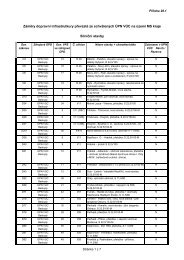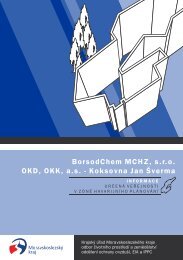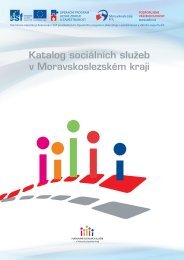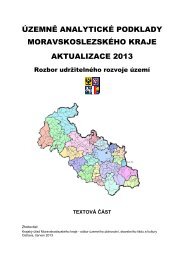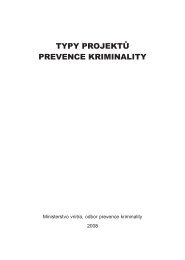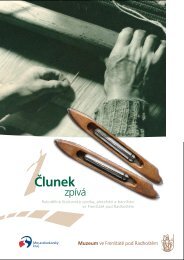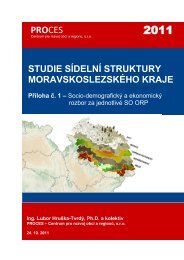JitÅenka východu (formát PDF; velikost 3,7 MB) - VeÅejná správa
JitÅenka východu (formát PDF; velikost 3,7 MB) - VeÅejná správa
JitÅenka východu (formát PDF; velikost 3,7 MB) - VeÅejná správa
- No tags were found...
Create successful ePaper yourself
Turn your PDF publications into a flip-book with our unique Google optimized e-Paper software.
3SummaryJitřenka východuIn the latter half of the 19th century Frenštát was a small town nestling at the foot of the mountains. Data fromthe population census of 1869 record 6563 inhabitants and 849 homes. The economic life of the town, based onemployment in agriculture, in the surrounding forest and on artisan production (primarily weaving) formed thepreconditions for the development of the textile industry, dyeing and the later knitting industry. At that time roads,bridges and the railway (operational from 1889) were being built. The face of the town was also being transformed intoits present appearance – the historical centre was undergoing architectural change: the establishment of a boys school(1876), a school for weaving (1905), the town hall (1891), the railway station (1888), textile mills were also built, theVlčina public house for day trippers (1895) and Horečky became a popular destination for holiday crowds, at Pustevnywere developed the rambling hostels (1891 – 1899) on Radhošť Mountain the St. Cyril and Methodius Chapel wasbuilt (1898) all of which became dominant features of the Radhošť Beskydy both at that time and well into the future.Frenštát had its day schools as well as a boys’ and girls’ grammar school, an occupational school for weavers, a secondaryschool for industry as well as local nursery and dame schools. A Czech public administration officiated at the townhall. The development of industrial production was beset by repeated economic crises and when combined with yearsof poor harvests and environmental disasters, brought hunger and poverty. This led to open social unrest, which wassuppressed by armed force (1890). This also led to emigration, the extent to which is borne out by comparing the 793homes and 5735 persons recorded in 1900, to the data given for 1869.For Frenštát, the second half of the 19th century proved auspiciously prosperous, it was a period that in the first instance significantlyshaped the spiritual atmosphere of Frenštát society, and later predetermined its steps in the approaching century.The Civic Forum (1861-1930) proved fertile ground for those attempts made in Frenštát to cultivate a more nationalist consciousness.From its patriotism, its enlightened and cultured environment, there grew, or were initiated, a plethora of societies andactivities – the Union of Theatre Enthusiasts (from 1875), the Society Book Collection (1875 – 1926), The Union of VoluntaryFiremen (from 1878), the Artisan Forum (from 1882), the Ethnicity Union (1883 – 1897), the Radhošť Mountain Association(1884 – 1950), TJ Sokol (1890 – 1950), the Christian – social club (1897 – 1948), the Decoration Club (1903 – 1951), the RadhošťFoundation (1903 – 1950). Its very existence set the course for the future social and cultural life of the town. With the aboveactivities are associated a host of personalities – Valentin Kostelník (1815 – 1891), MUDr. Rudolf Kallus (1834 – 1899), Jiří Felix(1856 – 1926), JUDr. Edvard Parma (1853 – 1921), Robert F. Křenek (1851 - 1928), Jindřich Kostelník (1849 - 1923) and EmilKostelník (1842 - 1919). As the point when the Czech national movement began to emerge from its slumbers, Frenštát waschristened ‘the morning star of the east’.29We can link the community’s early attempts at ethnography and museum curation to the inception and subsequent activities ofthe local Ethnic Union (1893 – the Ethnic, Industrial, Schools’ and Fine Art Exhibition was held in Frenštát, 1895 – it participatedat the Ethnic Exhibition of Czechoslovaks in Prague) and the later civil activities that led to the opening of the Municipal Museumof Frenštát p. R. in 1951 (from 1964 it became part of the present Nový Jičín Regional Museum). The historical and ethnographicbackground of the region, and the thematically amassed collections, both shaped the professional and the presentationalcharacter of the museum in its fields of interest (handweaving production and dyeing, expressions of folk creativity, traditionin the arts, the beginnings of Czech rambling, and more recently studies of emigration), fields which are now presented to thewider public. Since 1992 the civic association entitled the Museum and Ethnographic Society has been in operation. Besides themagazine Voices of the Museum in Frenštát pod Radhoštěm (until 2005) it also publishes a series of editions for bibliophiles,these are divided under three headings entitled Return Home, Profiles and Sources.Muzeum ve Frenštátě pod Radhoštěm




